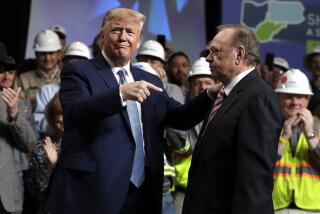Time to tax carbon
IF YOU HAVE KIDS, take them to the beach. They should enjoy it while it lasts, because there’s a chance that within their lifetimes California’s beaches will vanish under the waves.
Global warming will redraw the maps of the world. The U.N.’s Intergovernmental Panel on Climate Change predicts that sea levels will rise 7 to 23 inches by the end of the century; as the water gets higher, the sandy beaches that make California a tourist magnet will be washed away. Beachfront real estate will end up underwater, cliffs will erode faster, sea walls will buckle and inlets will become bays. The water supply will be threatened as mountain snowfall turns to rain and the Sacramento-San Joaquin Delta faces contamination with saltwater. Droughts will likely become more common, as will the wildfires they breed.
Global warming is happening and will accelerate regardless of what we do today, but the scenarios of climatologists’ nightmares can still be avoided. Though the cost will be high, it pales in comparison to the cost of doing nothing.
The proposed fixes for climate change are as numerous as its causes. Most only tinker at the edges of the problem, such as a California bill to phase out energy-inefficient lightbulbs. To produce the cuts in greenhouse gases needed to slow or stop global warming, the world will have to phase out the fossil fuels on which it relies for most of its power supply and transportation — especially the coal-burning power plants that account for about 32% of the annual emissions of carbon dioxide in the U.S. and that generate about half of our electricity. There are three basic methods of doing that, which are the subject of debate and legislation at every level of government.
Tax or trade?
The first is the simplest, and the least efficient: Just order the polluters to clean up. Unfortunately, that’s the strategy favored by the Legislature, which last year ordered that greenhousegas emissions in California be cut by 25% by 2020 and is now coming up with ways to meet the goal through conservation and regulation.The law isn’t specific about how to achieve the reduction, opening the door for Gov. Arnold Schwarzenegger to pursue Method No. 2: a cap-and-trade system. Under this system, the government decides how many tons of a given greenhouse gas can be emitted statewide and passes out credits to the emitters. Polluters trade credits among themselves; those for whom it’s relatively cheap to cut emissions sell credits to those for whom it’s expensive. In the last year, Schwarzenegger has been traveling around the country and the world signing cap-and-trade deals.
The difference between these methods is that the Legislature wants to impose a cap without any trade. This “command and control” strategy is extremely punitive to some polluters, such as utilities that rely heavily on dirty, old coal plants. Many will find it impossible to meet the state goal, exposing them to harsh fines — the costs of which they’ll pass on to their customers. Of all possible approaches, it would have the worst effect on the state economy.
Cap-and-trade isn’t just less expensive, it has proved to be workable. In 1995, the federal government launched a cap-and-trade program for sulfur dioxide, the main ingredient in acid rain. The goal was to reduce emissions to half their 1980 levels by 2010, and the program is expected to reach it or fall just short. It has become a model worldwide, leading signatories to the Kyoto Protocol to pursue an international cap-and-trade system for greenhouse gases. Moreover, the carbon-trading concept has widespread political and business support — even such gargantuan polluters as Duke Energy, BP America and General Motors have joined a corporate coalition calling for a federal cap-and-trade program.
And yet for all its benefits, cap-and-trade still isn’t the most effective or efficient approach. That distinction goes to Method No. 3: a carbon tax. While cap-and-trade creates opportunities for cheating, leads to unpredictable fluctuations in energy prices and does nothing to offset high power costs for consumers, carbon taxes can be structured to sidestep all those problems while providing a more reliable market incentive to produce clean-energy technology.
Europeans strike out
To understand the drawbacks of cap-and-trade, one has to look not only at the successful U.S. acid rain program but the failed European Emissions Trading Scheme, the first phase of which started in January 2005. European Union members each developed emissions goals, then passed out credits to polluters. Yet for a variety of reasons, the initial cap was set so high that the polluters fell under it without making any reductions at all. The Europeans are working to improve the scheme in the next phase, but their chances of success aren’t good.One reason is the power of lobbyists. In Europe, as in the U.S., special interests have a way of warping the political process so that, for example, a corporation generous with its campaign contributions might win an excessive number of credits. It’s also very easy in many European countries to cheat; because there aren’t strong agencies to monitor and verify emissions, companies or utilities can pretend they’re cleaner than they are.
The latter problem might be avoided in the U.S. by beefing up the Environmental Protection Agency. But there’s reason to suspect that many of the corporate interests pushing for a federal cap-and-trade program are hoping for a seat at the table when credits are passed out, and they will doubtless fudge numbers to maximize their credits; some companies stand to make a great deal of money under a trading system. Also hoping to profit, honestly or not, would be carbon traders. Large financial institutions would jump into the exchange to collect commissions on carbon trades, just as they do with crude oil and wheat. This presents opportunities for Enron-style market manipulation.
Cap-and-trade would also have a nasty effect on consumers’ power bills. Say there’s a very hot summer week in California. Utilities would have to shovel more coal to produce more juice, causing their emissions to rise sharply. To offset the carbon, they would have to buy more credits, and the heavy demand would cause credit prices to skyrocket. The utilities would then pass those costs on to their customers, meaning that power bills might vary sharply from one month to the next.
That kind of price volatility, which has been endemic to both the American and European cap-and-trade systems, doesn’t just hurt consumers. It actually discourages innovation, because in times when power demand is low, power costs are low, and there is little incentive to come up with cleaner technologies. Entrepreneurs and venture capitalists prefer stable prices so they can calculate whether they can make enough money by building a solar-powered mousetrap to make up for the cost of producing it.
Carbon taxes avoid all that. A carbon tax simply imposes a tax for polluting based on the amount emitted, thus encouraging polluters to clean up and entrepreneurs to come up with alternatives. The tax is constant and predictable. It doesn’t require the creation of a new energy trading market, and it can be collected by existing state and federal agencies. It’s straightforward and much harder to manipulate by special interests than the politicized process of allocating carbon credits.
And it could be structured to be far less harmful to power consumers. While all the added costs under cap-and-trade go to companies, utilities and traders, the added costs under a carbon tax would go to the government — which could use the revenues to offset other taxes. So while consumers would pay more for energy, they might pay less income tax, or some other tax. That could greatly cushion the overall economic effect.
Taxes a tough sell
There is a growing consensus among economists around the world that a carbon tax is the best way to combat global warming, and there are prominent backers across the political spectrum, from N. Gregory Mankiw, former chairman of the Bush administration’s Council on Economic Advisors, and former Federal Reserve Chairman Alan Greenspan to former Vice President Al Gore and Sierra Club head Carl Pope. Yet the political consensus is going in a very different direction. European leaders are pushing hard for the United States and other countries to join their failed carbon-trading scheme, and there are no fewer than five bills before Congress that would impose a federal cap-and-trade system. On the other side, there is just one lonely bill in the House, from Rep. Pete Stark (D-Fremont), to impose a carbon tax, and it’s not expected to go far.The obvious reason is that, for voters, taxes are radioactive, while carbon trading sounds like something that just affects utilities and big corporations. The many green politicians stumping for cap-and-trade seldom point out that such a system would result in higher and less predictable power bills. Ironically, even though a carbon tax could cost voters less, cap-and-trade is being sold as the more consumer-friendly approach.
A well-designed, well-monitored carbon-trading scheme could deeply reduce greenhouse gases with less economic damage than pure regulation. But it’s not the best way, and it is so complex that it would probably take many years to iron out all the wrinkles. Voters might well embrace carbon taxes if political leaders were more honest about the comparative costs.
The world is under a deadline. Some scientists believe that once atmospheric carbon dioxide levels have doubled from the pre-industrial level, which may happen by mid-century if no action is taken, the damage may be irreversible.
More to Read
A cure for the common opinion
Get thought-provoking perspectives with our weekly newsletter.
You may occasionally receive promotional content from the Los Angeles Times.










